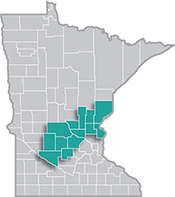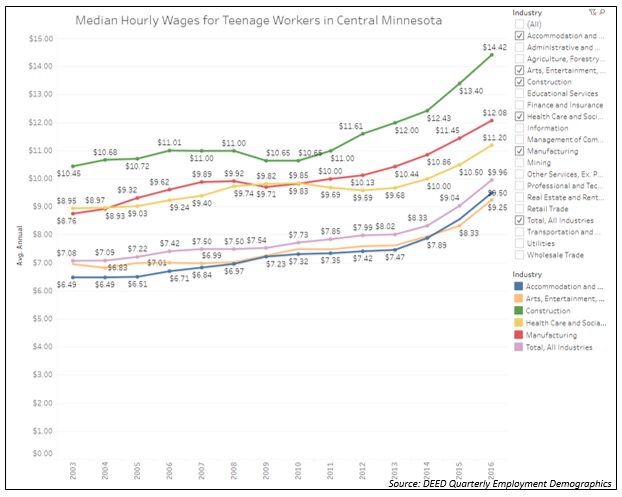 Central Minnesota is a manufacturing stronghold, with several global manufacturing firms operating there.
Central Minnesota is a manufacturing stronghold, with several global manufacturing firms operating there.
The region is especially well known for its expertise in food processing, printing, furniture manufacturing, appliances, machinery and heavy equipment manufacturing.
View our latest blogs on CareerForce. Want the freshest data delivered by email? Subscribe to our regional newsletters.
11/29/2017 10:09:32 AM
Luke Greiner
Young workers and low wages are often synonymous. With little experience and few skills, young workers largely fill entry-level jobs. However, not all workers in their teens and early twenties are earning wages near minimum. Depending on the industry, median hourly wages for young workers can vary significantly.
Thanks to new data provided by DEED’s Quarterly Employment Demographics (QED) program, this post will look at how central Minnesota’s economy is responding to shifts in the labor market, particularly for the youngest workers.
After nearly a decade of declining employment, the youngest workers in central Minnesota have begun claiming a larger share of total jobs. Back in 2003, 11.3 percent of jobs in the region were held by workers 19 years and younger. However, this group was impacted by the Great Recession more than any other age cohort, and by 2011 the percentage had dropped to just 8 percent of total jobs.
An increasing number of jobs are held by workers aged 55 years and older due to the size of that generation in the workforce, which naturally decreased the share that can be held by other cohorts. But the actual number of jobs held by teenagers had been shrinking from 2000-2011, as well. Since bottoming out in 2011, the share of teenaged workers has steadily climbed back to 9.1 percent as of 2016, while the number of jobs held by teenagers also increased for the first time in a decade.
In step with statewide minimum wage increases in 2014, 2015, and 2016, teenaged workers -- the lowest paid workers in the accommodation and food services industry -- saw their wages rise faster than any other age cohort. By 2016 the median hourly wage for workers under 20 years reached $9.50, while the median hours worked slowly crept higher since the end of the recession.
The construction industry has the highest median hourly wage for teenage workers, topping $14.42 per hour compared to a low of $9.25 for the arts, entertainment and recreation industry. The demand for construction industry labor has pushed median hourly wages for teenagers in central Minnesota to grow 3.8 times faster than inflation from 2010-2016. The next highest median hourly wage for teenage workers was $12.08 in manufacturing, and $11.20 in the health care and social assistance industry.
Median hourly wages for workers of all ages in central Minnesota grew by 15.2 percent from the end 2010-2016, far exceeding the 9.3 percent rate of inflation during that period. Possibly from a combination of regaining employment opportunities that young workers were pushed out of during the Great Recession, and substantial increases to the minimum wage, teenage workers enjoyed the fastest wage growth in general, increasing by 29 percent from 2010 to 2016.
Unlike wage growth for teenagers working in retail and accommodation and food service, the rise in construction industry pay was not directly impacted by minimum wage increases. Wages for teenage workers in the construction industry were higher than the minimum wage before the recent minimum wage increase, and was rising years before the policy became law. To see how median hourly wages have changed for teenaged workers in Central Minnesota, use this visualization.

For more on Quarterly Employment Demographics in Central Minnesota, contact Luke Greiner at 320-308-5378 or email Luke.Greiner@state.mn.us.